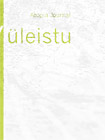| home | ||
| Atopia Journal: urg/üleistu | ||
|
CONTRIBUTORS: |
To some, urg might seem like nothing but a noise: a faucet gurgle, the ricochet of sound waves from an echoing kitchen, the noise a child hears, a good reason for hiding. The furnace monster clicks, pops, urgs. Suddenly urg is more than a noise. It bears the weight of that monster. Disconnected entities—a factual furnace or a figment of the mind—that will not merge until the “grown out” age; grown out of nightlights, stuffed animals, shudders from late-night thunder, and footed pajamas. Yet when an adult hears urg, the sound generates an associative response. This reaction is based on the listener’s language and perception. Urg becomes a syllogism: words are made of sounds, urg is a sound, and therefore a word must be made of urg. Unbeknownst to the monster, this logic is true. Urg is a catalyst; it is a motivator. It entreats and solicits, stimulates and impels. Like the stairs that connect the levels of a structure, understanding urg is about negotiation. Whether traveled by creature, object or human, those stairs are a space of concession: shared but still unoccupied zones. These spaces—rational arguments, experiential differences, and physical constructions—facilitate the potential for change and further understandings. This issue of Atopia Journal presents diverse models of negotiations, communications, and resolutions, which occur within different spheres. These spheres can be divided into two categories: a chasm surrounded by disparity, or an overlay forged from commonality. Each contributor in this publication examines the gaps and overlaps critical to a subject. Through artistic, scientific, political, and cultural work, they relate the spectrum of negotiation to the human experience. urg/üleistu is a literal translation into Mänti—a language developed by mathematic and linguistic savant Daniel Tammet—of the English phrase “gap/overlap.” The contents of this publication suspend us between monster and mirage, in order to provoke the question: where does negotiation happen? –Guest Editorial Group |
|
